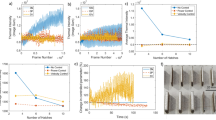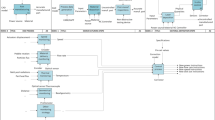Abstract
The industrialization of additive manufacturing strongly relies on the robustness of the process. In particular, the more complex Directed Energy Deposition (DED) processes offer great flexibility and higher build-up rates on the one hand, but on the other hand they pose challenges until a part can be printed with the desired properties. This paper adopts and compares different approaches, i.e. linear, sliding mode and model-based controller, for online process regulation of track height and width using a novel industrial sensor setup. Based on single track experiments, control parameters are determined and results of the closed loop analyzed. As a result, the linear controller shows the best performance and robustness. The performance for the track width can even be improved by a Linear Quadratic Gaussian (LQG) controller. Finally, the performance of the linear control strategy is tested with a complex motor cover part. Additionally, a digital twin representation shows the spatial representation of the process parameters and region of interests where thresholds or predefined process rules are violated.












Similar content being viewed by others
Abbreviations
- DED:
-
Directed Energy Deposition
- CAD:
-
Computer Aided Design
- AM:
-
additive manufacturing
- CNC:
-
Computer Numerical Control
- CMOS:
-
Complementary Metal Oxide Semiconductor
- NC:
-
Numerical Control
- ILC:
-
Iterative Learning Control
- NARX:
-
Nonlinear Autoregressive Network with Exogenous Inputs
- MLP:
-
Multilayer Perceptron
- PI:
-
Proportional Integral
- PID:
-
Proportional Integral Derivative
- SISO:
-
Single Input, Single Output
- MIMO:
-
Multiple Input, Multiple Output
- IDM\(^{{\circledR }}\) :
-
In-Process Depth Meter\(^{{\circledR }}\)
- px:
-
pixel
- FPS:
-
frames per second
- px:
-
pixel
- SLD:
-
Superluminescent Diode
- OP:
-
operating point
- I:
-
integral
- TF:
-
transfer function
- LQG:
-
Linear Quadratic Gaussian
- LQR:
-
Linear Quadratic Regulator
- SVD:
-
Singular Value Decomposition
- MSE:
-
Mean Square Error
References
Associates W (2017) 3D printing and additive manufacturing - state of the industry, tech. rep. Fort Collins
Ioana AD, Maria ED, Cristina V (2020) Case study regarding the implementation of one-piece flow line in automotive company. Procedia Manuf 46:244–248
Savolainen J, Collan M (2020) How additive manufacturing technology changes business models? – review of literature. Addit Manuf 32(December 2019):1–15
Piscopo G, Iuliano L (2022) Current research and industrial application of laser powder directed energy deposition. Int J Adv Manuf Technol 119:6893–6917
Ahn D-G (2021) Deposition, directed energy (DED) process: state of the art. Int J Pr Eng Man-GT 8:703–742
Hofman JT, Pathiraj B, Dijk JV, Lange DFD, Meijer J (2012) Journal of materials processing technology a camera based feedback control strategy for the laser cladding process. J Mater Process Tech 212(11):2455–2462
Hofman JT, Pathiraj B, Van Dijk J, De Lange DF, Meijer J (2012) A camera based feedback control strategy for the laser cladding process. J Mater Process Technol 212(11):2455– 2462
Lim KYH, Zheng P, Chen CH (2020) A state-of-the-art survey of digital twin: techniques, engineering product lifecycle management and business innovation perspectives. J Intell Manuf 31(6):1313–1337
Iravani-Tabrizipour M, Toyserkani E (2007) An image-based feature tracking algorithm for real-time measurement of clad height. Mach Vis Appl 18(6):343–354
Asselin M (2006) Optical sensor for real-time measurement of clad height during laser cladding process. PhD thesis, University of Waterloo
Fathi A, Khajepour A, Toyserkani E, Durali M (2007) Clad height control in laser solid freeform fabrication using a feedforward PID controller. Int J Adv Manuf Technol 35:280–292
Fathi A, Khajepour A, Durali M, Toyserkani E (2008) Geometry control of the deposited layer in a nonplanar laser cladding process using a variable structure controller. J Manuf Sci Eng Trans ASME 130(3):1–11
Zeinali M, Khajepour A (2010) Height control in laser cladding using adaptive sliding mode technique: theory and experiment. J Manuf Sci Eng Trans ASME 132(4):1–10
Borovkov H, de la Yedra AG, Zurutuza X, Angulo X, Alvarez P, Pereira JC, Cortes F (2021) In-line height measurement technique for directed energy deposition processes. J Manuf Mater Process 5(3):85
Zeinali M, Khajepour A (2010) Adaptive fuzzy sliding mode control design for laser metal deposition. Proceedings of the 2010 American Control Conference, pp 6115–6120
Sammons PM, Gegel ML, Bristow DA, Landers RG (2018) Repetitive process control of additive manufacturing with application to laser metal deposition. IEEE Trans Control Syst Technol 27(2):1–10
Heralić A, Christiansson AK, Lennartson B (2012) Height control of laser metal-wire deposition based on iterative learning control and 3D scanning. Opt Lasers Eng 50(9):1230–1241
Das A, Mukherjee S, Giri SK, Lohar AK (2017) An improved learning based multilayer height control strategy in LMD process. In: IEEE India Council International Conference (INDICON), pp 1–6. IEEE
Rodríguez-araújo J, Rodríguez-andina JJ, Fariña J, Vidal F, Montealegre MÁ (2012) Industrial laser cladding systems: FPGA-based adaptive control. IEEE Ind Electron Mag 6(4):35– 46
Moralejo S, Penaranda X, Nieto S, Barrios A, Arrizubieta I, Tabernero I, Figueras J (2017) A feedforward controller for tuning laser cladding melt pool geometry in real time. Int J Adv Manuf Technol 89(1-4):821–831
Bollig A, Abel D, Kratzsch C, Kaierle S (2003) Identification and predictive control of laser beam welding using neural networks. In: European control conference (ECC), pp 2457–2462. IEEE
Masinelli G, Le-Quang T, Zanoli S, Wasmer K, Shevchik SA (2020) Adaptive laser welding control: a reinforcement learning approach. IEEE Access 8:1–15
Moralejo S, Penaranda X, Nieto S, Barrios A, Arrizubieta I, Tabernero I, Figueras J (2017) A feedforward controller for tuning laser cladding melt pool geometry in real time. Int J Adv Manuf Technol 89(1–4):821–831
Tang L, Ruan J, Landers RG, Liou F (2008) Variable powder flow rate control in laser metal deposition processes. J Manuf Sci Eng Trans ASME 130(4):1–11
Ali N, Tomesani L, Ascari A, Fortunato A (2022) Fabrication of thin walls with and without close loop control as a function of scan strategy via direct energy deposition. Lasers Manuf Mater Process 9 (1):81–101
Farshidianfar MH (2014) Control of microstructure in laser additive manufacturing. PhD thesis, University of Waterloo
Farshidianfar MH, Khajepour A, Gerlich AP (2016) Effect of real-time cooling rate on microstructure in Laser Additive Manufacturing. J Mater Process Technol 231:468–478
Farshidianfar MH, Khajepour A, Gerlich A (2016) Real-time control of microstructure in laser additive manufacturing. Int J Adv Manuf Technol 82:1173–1186
Salehi D, Brandt M (2006) Melt pool temperature control using LabVIEW in Nd:YAG laser blown powder cladding process. Int J Adv Manuf Technol 29(3-4):273–278
Song L, Mazumder J (2011) Feedback control of melt pool temperature during laser cladding process. IEEE Trans Control Syst Technol 19(6):1349–1356
Devesse W, De Baere D, Hinderdael M, Guillaume P (2016) Hardware-in-the-loop control of additive manufacturing processes using temperature feedback. J Laser Appl 28(2):1–14
Hua T, **g C, **n L, Fengying Z, Weidong H (2008) Research on molten pool temperature in the process of laser rapid forming. J Mater Process Technol 198:454–462
Tan H, Chen J, Zhang F, Lin X, Huang W (2010) Estimation of laser solid forming process based on temperature measurement. Opt Laser Technol 42(1):47–54
Mazumder J, Dutta D, Kikuchi N, Ghosh A (2000) Closed loop direct metal deposition: art to part. Opt Lasers Eng 34:397–414
Bontha S, Klingbeil NW, Kobryn PA, Fraser HL (2009) Effects of process variables and size-scale on solidification microstructure in beam-based fabrication of bulky 3D structures. Mater Sci Eng A 514:311–318
Bi G, Gasser A, Wissenbach K, Drenker A, Poprawe R (2006) Identification and qualification of temperature signal for monitoring and control in laser cladding. Opt Lasers Eng 44(12):1348–1359
Bi G, Gasser A, Wissenbach K, Drenker A, Poprawe R (2006) Characterization of the process control for the direct laser metallic powder deposition. Surf Interface Anal 201(6):2676–2683
Bi G, Schürmann B, Gasser A, Wissenbach K, Poprawe R (2007) Development and qualification of a novel laser-cladding head with integrated sensors. Int J Mach Tools Manuf 47:555–561
Bi G, Sun CN, Gasser A (2013) Study on influential factors for process monitoring and control in laser aided additive manufacturing. J Mater Process Technol 213(3):463–468
Tang L, Landers RG (2010) Melt pool temperature control for laser metal deposition processes-part I: online temperature control. J Manuf Sci Eng Trans ASME 132(1):1–9
Behlau F, Thiele M, Maack P, Esen C, Ostendorf A (2022) Layer thickness controlling in direct energy deposition process by adjusting the powder flow rate. Procedia CIRP 111:330–334
Arrizubieta JI, Martínez S, Lamikiz A, Ukar E, Arntz K, Klocke F (2017) Instantaneous powder flux regulation system for laser metal deposition. J Manuf Process 29:242–251
Liu J, Li L (2004) In-time motion adjustment in laser cladding manufacturing process for improving dimensional accuracy and surface finish of the formed part. Opt Laser Technol 36(6):477–483
Kogel-Hollacher M, Strebel M, Staudenmaier C, Schneider H-I, Regulin D (2020) OCT sensor for layer height control in DED using SINUMERIK®; controller. In: Helvajian H, Gu B, Chen H (eds) Laser 3D manufacturing VII, p 23, SPIE
Kogel-Hollacher M, André S, Beck T (2018) Low-coherence interferometry in laser processing: a new sensor approach heading for industrial applications. In: North Morris MB, Creath K, Burke J, Davies ED (eds) Interferometry XIX, p 52 SPIE
Carvajal A (2005) Quantitative comparison between the use of 3D vs 2D visualization tools to present building design proposals to non-spatial skilled end users. IEEE
Neugebauer R, Denkena B, Wegener K (2007) Mechatronic systems for machine tools. CIRP Ann Manuf Technol 56(2):657–686
Berners T, Regulin D, Barucci R, Epple A, Brecher C (2019) Monitoring and closed-loop building height controller for LMD-processes. In: LAMP 2019 - 8th international congress on laser advanced materials processing , (Hiroshima, Japan)
Agachi PS, Nagy ZK, Cristea MV, Imre-Lucaci Á (2007) Model based control: case studies in process engineering. Wiley, New York
Ruderman M, Krettek J, Hoffmann F, Bertram T (2008) Optimal state space control of DC motor. IFAC Proc 41(2):5796–5801
Gillard J, Usevich K (2022) Hankel low-rank approximation and completion in time series analysis and forecasting: a brief review. Stat Interface 0(1):1–18
Funding
This work was funded by the Siemens Aktiengesellschaft (Siemens AG).
Author information
Authors and Affiliations
Contributions
Daniel Regulin (conceptualization, investigation, methodology, funding acquisition); Raffaele Barucci (controller design, parametrization and validation)
Corresponding author
Ethics declarations
Competing interests
The authors declare no competing interests.
Additional information
Publisher’s note
Springer Nature remains neutral with regard to jurisdictional claims in published maps and institutional affiliations.
Rights and permissions
Springer Nature or its licensor (e.g. a society or other partner) holds exclusive rights to this article under a publishing agreement with the author(s) or other rightsholder(s); author self-archiving of the accepted manuscript version of this article is solely governed by the terms of such publishing agreement and applicable law.
About this article
Cite this article
Regulin, D., Barucci, R. A benchmark of approaches for closed loop control of melt pool shape in DED. Int J Adv Manuf Technol 126, 829–843 (2023). https://doi.org/10.1007/s00170-023-11042-8
Received:
Accepted:
Published:
Issue Date:
DOI: https://doi.org/10.1007/s00170-023-11042-8




